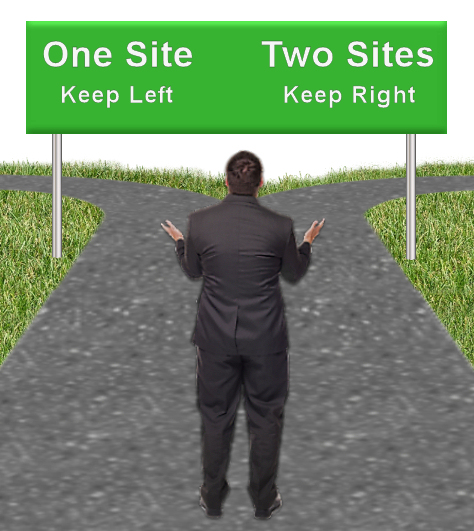
As a small business, if you have a large site, should you split it into two websites or leave it as one? This is a difficult question that really has no right or wrong answer, but we’ll give you something even better: we’ll help you examine some of the ups and downs of both options to help you decide what’s best for you.
Maintaining One Large Site
Offering everything in one place is convenient for you and your target audience. You only have one set of expenses, one set of marketing and content strategies, one set of social media profiles, and only have to go to one location to update and maintain your content. When it comes to ranking and link juice, you have more pages use can use to rank and will be able to catch with the long tail.
Unfortunately, there are some downsides to having everything on one site:
- Too much content can be difficult for users to wade through. They’ll have to go through more content to find what they’re looking for.
- A larger site means a larger audience. This makes it far more difficult to target specific visitors.
- The more general your targeting, the lower your conversion rate generally is, simply because you have to get visitors past the things they’re not interested in to get them through the sales funnel.
- The wider your audience, the wider your reach has to be and the more spread out your marketing strategies need to be.
- Larger sites require better databases and more resources to run than smaller sites (often split onto subdomains). Sometimes, for smaller businesses, this may go beyond your current resources.
Breaking Your Site Into Two Or More Sites
Splitting your website onto two or more main domains can have a multitude of benefits. Each site can be tailored to meet the needs of a specific audience, including the design and site architecture. Each site can have its own branding and carry its own loyal customers.
Financially, running more than one site may also have some benefits. Since you have two properties, you have two separate investments that can grow. Also, if something should happen to one of the sites (say it falls in the rankings, for example), you have another site that will continue to generate revenue until the affected site recovers.
With two sites, there is often the chance to benefit from the competition as well. You have two sites to conquer more of the market and a wider range of terms, products, services, and audiences. Also, it’s possible that if customers don’t buy from one site, they’ll buy from the other, which is often the case with real world stores.
Like with one main site, there are some downsides to consider with multiple sites:
- You have twice as many sites to upgrade, create, and maintain.Both sites need consistent content, have current social profiles, and need fresh marketing ideas.
- Both sites require links, SEO, and attention/traffic
- You need two distinct audiences, otherwise you’ll dilute your offering.
Questions You Need To Be Asking
Here are a few things you’ll need to ask yourself before choosing a path:
- Do you have two distinct visitors (buyers) coming to the site for different reasons?
- Are you able to separate the site into two ‘themes’ to create two brands that can stand on their own?
- Do you have the resources available to market, run, and maintain two sites?
- Will you benefit enough to warrant splitting the site or creating two separate sites (ROI)?
- What are your plans for each website? Is there a way to grow them both together, or will your expansions take the two sites farther apart from each other?
Have you split your site onto two domains or decided to run one large site? What have your experiences been?